|

by Laura Knight-Jadczyk
The Dot Connector Magazine
30 October 2010
from
Fireballs-MeteoritesBlogspot
Website
When you think of Halloween, what is the first image that comes to
mind?
I took a little informal poll among my
friends, family and associates. Guess what image came in first?
Jack-o-lanterns! Bet you thought I was going to say "witches".
Well,
I sure thought it would be witches, but they only came in a close
second!..
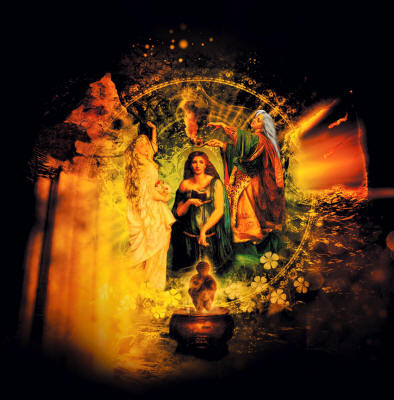
When I think of Halloween, I think of
grade-school art projects where we cut out silhouettes of witches to
paste onto large yellow moons made of construction paper.
The witch
was always on a broom with her black dress flying in the wind,
accompanied by a black cat sitting on the back of the broom. I
wondered even then how the cat managed to stay on and why anybody
would think that straddling a broomstick as a seat would be even
remotely comfortable.
But, there you have it: in a significant way, Halloween is
associated with witches, evil women who consort with the devil and
do evil things like caging lost children to fatten them up and eat
them, giving poisoned apples and setting up spinning wheels to
poison abandoned or hapless princesses who are only looking for true
love.
The word 'witch' comes to us from the Old English wicca,
which was a masculine word meaning 'wizard'. The feminine version
was wicce, pronounced 'witch'. This came from Middle High
German wicken , which meant to 'bewitch', and even older,
from Old High German wīh which meant 'holy'.
The dictionary tells us that a witch is
someone who has malignant supernatural powers and practices spell
casting with the aid of a devil or familiar. It also refers to an
ugly old woman, or a beautiful young woman. The word 'witch' is an
epithet for any woman who isn't inclined to be a doormat, flung to
the floor by any individual who wants her to be subject to his or
her will.
Last of all, a witch is a practitioner
of Wicca.
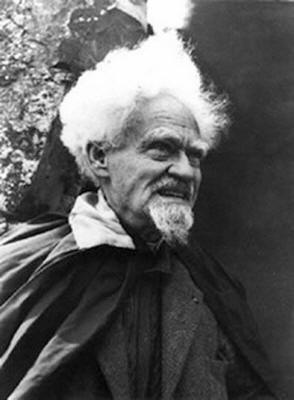
Gerald Gardner
Wicca is a British construct created by an amateur anthropologist
named Gerald Gardner who claimed to have had many interesting
encounters and experiences with the occult and paranormal throughout
his life.
At one point, he claimed to have
doctoral degrees from the Universities of Singapore and Toulouse,
which was a lie. He claimed that he was initiated into a New Forest
coven of witches which was the survival of a pre-Christian pagan
witch cult. This alleged ancient coven has been shown by subsequent
research to have been formed in the early 20th century
and its ideas were based mainly on folk magic and the theories of
Margaret Murray, so again, his honesty is rather suspect.
Gardner incorporated elements from
Freemasonry,
ceremonial magic, and the
imaginings of
Aleister Crowley and others.
Most of what one sees when carefully examining these elements that
combined to form modern Wicca bears no relationship whatsoever to
the ancient religions as they can be discerned by deep study.
Rather, these elements are likely more
influenced by taking the descriptions of the persecutors of witches
during the Inquisition as a guideline, instead of realizing that
they were the defamatory falsifications of psychopaths. It is more
likely that those accused of witchcraft during the witch
persecutions were following beliefs akin to those of
the Cathars - dualism - or even more ancient dualistic
concepts.
They also likely employed ancient
knowledge handed down from Paleolithic shamanic systems which had
little to nothing to do with 'ceremonial magic', spells or a
'liberal code of morality'. Unfortunately, neither Gardner nor
Crowley had access to modern scientific archaeological studies from
which one can actually infer something about the abilities, beliefs
and practices of our truly remarkable ancestors.
My work is all about following the lines of Pagan/shamanistic
ideas and teachings back to the Ice Ages - the cave painters,
the Northern European origins - to find the most original,
fundamental, common foundation of all of them. The idea that there
was a time when man was directly in contact with the Celestial
Beings is at the root of many of the myths of the Golden Age.
Myths tell us of a time when the 'gods
withdrew' from mankind.
As a result of some 'happening', i.e.,
'The Fall', when the communications were broken off and the
Celestial Beings withdrew to the highest heavens.
But the myths also tell us that there were still certain people who
were able to 'ascend' and commune with the gods on behalf of their
tribe or family. Through them, contact was maintained with the
'guiding spirits' of the group. The beliefs and practices of present
day shamans are a survival of a profoundly modified and even
corrupted and degenerated remnant of this archaic technology of
concrete communications between heaven and earth.
This
shamanism seems to have been born in Western Europe with
the arrival of Cro-Magnon man and the myths seem to have been
redacted repeatedly until we have numerous claims of occult secrets
of various sorts revived by this or that person, including Wicca.
If that is the case, then true
'witchcraft' is really shamanism, aka Druidism, and even more, as we
shall see.
Mircea Eliade writes:
Recent researches have clearly
brought out the 'shamanic' elements in the religion of the
Paleolithic hunters. Horst Kierchner has interpreted the
celebrated relief at Lascaux as a representation of a shamanic
trance.
...Finally, Karl J. Narr has reconsidered the problem of the
'origin' and chronology of shamanism in his important study. He
brings out the influence of notions of fertility (Venus
statuettes) on the religious beliefs of the prehistoric North
Asian hunters; but this influence did not disrupt the
Paleolithic tradition...
It is in this "Vorstellungswelt"
that the roots of the bear ceremonialism of Asia and North
America lie. Soon afterward, probably about 25,000 BC, Europe
offers evidence for the earliest forms of shamanism (Lascaux)
with the plastic representations of the bird, the tutelary
spirit, and ecstasy.
...What appears to be certain is the antiquity of 'shamanic'
rituals and symbols.
It remains to be determined whether
these documents brought to light by prehistoric discoveries
represent the first expressions of a shamanism in statu nascendi
or are merely the earliest documents today available for an
earlier religious complex, which, however, did not find
'plastic' manifestations (drawings, ritual objects, etc.) before
the period of Lascaux.
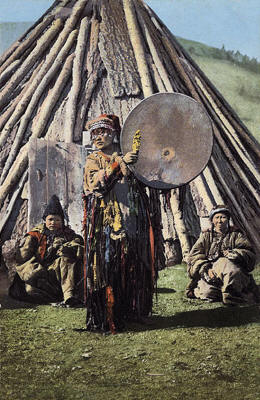
A female shaman from the Altai mountains.
...It is indubitable that the celestial ascent of the shaman is
a survival, profoundly modified and sometimes degenerate, of
this archaic religious ideology centered on faith in a celestial
Supreme Being and belief in concrete communications between
heaven and earth.
...The myths refer to more intimate relations between the
Supreme Beings and shamans; in particular, they tell of a First
Shaman, sent to earth by the Supreme Being or his surrogate to
defend human beings against diseases and evil spirits."
It was in the context of the
'withdrawal' of the 'Celestial Being' that the meaning of the
shaman's ecstatic experience changed.
Formerly, the activity was focused on
communing with the god and obtaining benefits for the tribe. The
shift of the function of the shaman associated with the withdrawal
of the benevolent god/goddess was to 'battling with evil spirits and
disease'. This is a sharp reminder of the work of Jesus,
healing the sick and casting out demons - the shamanic exemplar
'after the Fall'.
There was, it seems, another consequence of this 'shift'.
Increasingly, the descents into the 'underworld' and the relations
with 'spirits' led to their 'embodiment' or in the shaman's being
'possessed' by 'spirits'. What is clear is that these were
innovations, most of them recent.
What is particularly striking in the
research of the historiographers of myth, legend, shamanism, etc.,
is the discovery of the,
"influences from the south, which
appeared quite early and which altered both cosmology and the
mythology and techniques of ecstasy".
Among these southern influences were the
contribution of Buddhism and Lamaism, added to the Iranian and, in
the last analysis, Mesopotamian influences that preceded them.
The initiatory schema of the
shaman's ritual death and resurrection is likewise an
innovation, but one that goes back to much earlier times; in any
case, it cannot be ascribed to influences from the ancient Near
East.
But the innovations introduced by
the ancestor cult particularly affected the structure of this
initiatory schema.
The very concept of mystical death
was altered by the many and various religious changes effected
by lunar mythologies, the cult of the dead, and the elaboration
of magical ideologies.
Hence we must conceive of Asiatic shamanism as an archaic
technique of ecstasy whose original underlying ideology - belief
in a celestial Supreme Being with whom it was possible to have
direct relations by ascending into the sky - was constantly
being transformed by an ongoing series of exotic contributions
culminating in the invasion of Buddhism...
The phenomenology of the trance underwent many changes and
corruptions, due in large part to confusion as to the precise
nature of ecstasy. Yet all these innovations and corruptions did
not succeed in eliminating the possibility of the true shamanic
ecstasy.
More than once we have discerned in the shamanic experience a
'nostalgia for paradise' that suggests one of the oldest types
of Christian mystical experience. As for the 'inner light',
which plays a part of the first importance in Indian mysticism
and metaphysics as well as in Christian mystical theology, it is
already documented in shamanism.
What seems to be most important about Central Asian shamanism in
the history of mysticism is the role the shaman plays in the
defense of the psychic integrity of the community. Shamans are
pre-eminently the anti-demonic champions; they combat not only
demons and disease, but also the black magicians.
The shaman is the tireless slayer of
demons and dragons.
... It is clear that shamanism, as it is known, has declined
from its original unified and coherent system. One reason for
thinking so is that, while there are many local terms for a male
shaman, there is only one for a female shaman. Shamanism, it
seems, was formerly a woman's activity. In one Tartar dialect,
utygan, the word for a woman-shaman, also means 'bear'.
... The magico-religious value of intoxication for achieving
ecstasy is of Iranian origin. ... Concerning the original
shamanic experience ... narcotics are only a vulgar substitute
for 'pure' trance.
The use of intoxicants is a recent innovation and points to a
decadence in shamanic technique. Narcotic intoxication is called
on to provide an imitation of a state that the shaman is no
longer capable of attaining otherwise.
Decadence or vulgarization of a
mystical technique - in ancient and modern India, and indeed all
through the East, we constantly find this strange mixture of
'difficult ways' and 'easy ways' of realizing mystical ecstasy
or some other decisive experience."
(Ibid.)
Now, let me make a point here.
The religion of the Ice Age was so
satisfying to all the peoples of the Earth that it was stable for
over 25,000 years, as is evidenced by the archaeological and
historical data. There were shamans, women, who engaged in ecstatic
ascents which brought benefits to the tribe and, later, defended the
tribe against negative influences.
In short, it seems that Paganism, even
Druidism, was the original Christianity, and the original 'Christed
Ones' were women.
Many researchers repeatedly point out
that Christianity has pagan roots. Well, yeah; more than anybody
suspects. And if the lines of research I have presented in 'The
Secret History of the World,' are anything to go by, then
the original 'witches' were Christs.
This, of course, leads us to wonder how can things get so turned
around that we actually end up believing the opposite of the truth
in almost every field of endeavor? We may turn away from mainstream
religions that we can see are false and contradictory, only to fall
into the arms of New Age religions that are not any better, being
just another variation on a control system designed to prevent us
from accessing what is real.
It is going to be difficult for me to
boil this down into the short space I am given for this article, but
I will do my best. Just keep in mind that I am not going to be able
to provide extensive quoted evidence from primary sources, which is
my general way of writing. If you wish to know more, you can read my
books which go into these matters in great depth and detail.
The last day of October is a holiday that is said to be the ancient
Celtic celebration of the 'End of Summer', Samhain, Halloween, or
All Hallows Eve.
As I mentioned at the beginning, many
people think of witches when you say the word 'Halloween'. One
immediately wonders why October 31st should be associated
with witches and celebrated as the 'end of summer' when the Autumnal
equinox, over a month earlier, is the actual end of summer?
Therein lies the tale!
According to British historian Ronald Hutton, the festival of
Samhain celebrates the end of the
'lighter half' of the year and beginning of the 'darker half' and is
sometimes regarded as the Celtic New Year.
According to folklorist John
Gregorson Campbell and archaeologist Bettina Arnold, the
ancient Celts believed that the curtain separating this world from
the Otherworld became thin on Samhain, allowing spirits (both good
and bad) to easily traverse the otherwise sturdy barrier. They dealt
with this by inviting the good spirits in - usually family ancestors
- and utilizing various techniques to ward off or scare away any bad
spirits.
It is suggested that this is the origin
of wearing costumes disguising oneself as skeletons, ghosts, and
goblins, the principle being that if you looked horrible enough, you
could even scare away the devil himself!
Samhain was also the time when people in the old times took stock of
their food supplies, butchered cattle and pigs, and prepared grains
and other foodstuffs to put up for the winter.
Bonfires were an important part of the celebrations. Hearth fires
were put out, the bones of the slaughtered cattle were tossed into
the bonfire, and each home re-lit their hearth fire from the coals
of the bonfire. Sometimes two bonfires would be built so that people
could pass between them with their livestock for 'purification'.
This practice may be a survival of the
times when the ancient tribes purified themselves by burning alive:
-
any members who were less than
perfect so that the tribe could be cleansed of sinful
elements
-
those members who were actually
perfect in some way and volunteered to be offered as a
sacrifice to appease the gods so the rest of the tribe could
live in peace for another year
This is, in fact, an interesting clue.
The name 'Halloween' is an old Scottish variant of 'All Hallows
Eve', or the night before All Hallows Day, or the Feast of All
Saints. What is interesting to observe here are the old customs
regarding this day, and especially the following two days, from
around the world that were later Christianized, but obviously
represent something far more ancient.
In Portugal and Spain, offerings are made on All Saints Day. In
Mexico, All Saints coincides with the celebration of the Day of the
Innocents, part of the Day of the Dead honoring deceased children
and infants. In Portugal, children go door to door where they
receive cakes, nuts and pomegranates.
The holiday focuses on family gatherings
where prayers for, and remembrance of, friends and family that are
departed are the focus.
Traditions include building altars
honoring the deceased, feasting on sugar skulls (devouring death?),
and the favorite foods and beverages of the departed, decorating
with marigolds and visiting graves with these as gifts. Scholars
trace the origins of the modern holiday to indigenous observances
dating back thousands of years and to an Aztec festival dedicated to
a goddess called
Mictecacihuatl, the Queen of
Mictlan, or the underworld.
It was believed that she was sacrificed
as an infant, and she is represented with a defleshed body, and her
gaping jaw swallows the stars during the day.

Mexican ‘day
of the dead’ offerings,
including sugar
skulls.
In the Philippines, this day is called 'Undas', 'Todos los Santos'
(literally 'All Saints'), and sometimes 'Araw ng mga Namayapa'
(approximately 'Day of the Deceased').
This day and the one before and one
after it are spent visiting the graves of deceased relatives, where
prayers and flowers are offered, candles are lit and the graves
themselves are cleaned, repaired and repainted. The practices are
similar in most European countries.
In Brazil, Dia de Finados is a public holiday that many
Brazilians celebrate by visiting cemeteries and churches. In Spain,
there are festivals and parades, and, at the end of the day, people
gather at cemeteries and pray for their dead loved ones. Similarly
themed celebrations appear in many Asian and African cultures.
These celebrations, which occur on November 1st and 2nd,
and have indigenous forms that the church assimilated, strike us as
curious. It seems that what is important is that they follow
immediately on the heels of October 31st.
One is compelled to ask why. What
happened on October 31st that turned the following day
into the Day of the Dead?
The symbols associated with Halloween formed over time and, just as
the medieval church assimilated the ancient death-themed images and
practices, many of the customs of contemporary times have
assimilated the medieval practices. In traditional Celtic Halloween
festivals, large turnips were hollowed out, carved with faces and
placed in windows to ward off evil spirits.
The American tradition of carving
pumpkins was originally associated with harvest time in general, not
becoming specifically associated with Halloween until the
mid-to-late 1800s.
While most Christians just think of Halloween as a secular holiday
which allows kids (and big kids!) to dress up in silly costumes, eat
candy, and generally make fun of everything that is normally scary
in our world, some other - mostly fundamentalist - Christians
ascribe a negative influence to the celebration because they feel it
celebrates paganism, the occult, or trivializes it
so that their members are not properly fearful of ghosts, demons and
the devil.
Jehovah's Witnesses do not celebrate
Halloween because they believe anything that originated from a pagan
holiday should not be celebrated by true Christians. This is ironic
considering what I have written above about original Christianity.
How did we get from there - true
spirituality that honored women, with women shamans that provided
for the tribe - to here, the modern-day Christian view of women as
something barely human?
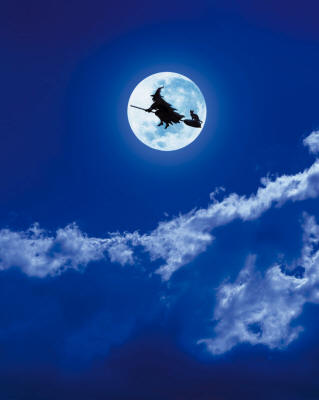
Many of those who follow Pagan ways consider the season to be a holy
time of year and, naturally, Wiccans feel that the whole holiday as
it is generally celebrated, is offensive because it associates
witches with the other list of 'evil spirits' that need to be warded
off.
They are right about that, but most of
what they consider 'Wicca' is as wrong as Christianity is wrong.
This brings us back to the question this article hopes to answer:
What is the origin of Halloween,
what does it really commemorate, and why are witches associated
with it?
The first point I would like to bring up
is that I think, when we look at Halloween, we are seeing something
very ancient that is filtered through many layers of interpretation.
What is consistent throughout, however,
is the theme of easy traversal of the border between life and death,
leading mainly to death, which suggests that death on a massive
scale came on Halloween a very long time ago.
Whatever it was, it was so terrifying,
so widespread, that cultures the world over have commemorated it,
and the days following it, in ways that appear to be designed to
ward it off, to prevent it from ever happening again. And along the
way, things happened that turned everything around so that those
individuals - real, holy, witches - who actually might be capable of
knowing such things, of ameliorating such terrors, became identified
with the cause of the death and destruction.
In the book, The Worship of the Dead, or the Origin and
Nature of Pagan Idolatry and Its Bearing Upon the Early History of
Egypt and Babylonia, by John Garnier (1904, pages 3-11), the
author writes that the modern-day celebrations for the dead focused
around All Hallows Eve, including the following few days, originated
to memorialize the people who died in the Deluge brought by God
on a wicked world.
He bases this on Genesis 7:11.
He writes:
"There is hardly a nation or tribe
in the world which does not possess a tradition of the
destruction of the human race by a flood; and the details of
these traditions are too exactly in accordance with each other
to permit the suggestion, which some have made, that they refer
to different local floods in each case.
The mythologies of all the ancient nations are interwoven with
the events of the Deluge and are explained by it, thereby
proving that they are all based on a common principle, and must
have been derived from a common source.
It is clear from these remarks that one or other of the two
great events in the history of the Deluge, namely, the
commencement of the waters and the beginning of their
subsidence, were observed throughout the ancient world, some
nations observing one event and some the other.
It would also appear probable that the observance of this
festival was intimately connected with, and perhaps initiated,
that worship of the dead which, as we shall see, was the central
principle of the ancient idolatry.
The force of this argument is illustrated by the fact of the
observance of a great festival of the dead in commemoration of
the event, not only by nations more or less in communication
with each other, but by others widely separated, both by the
ocean and by centuries of time.
This festival is, moreover, held by all on or about the very day
on which, according to the Mosaic account, the Deluge took
place, viz. the seventeenth day of the second month - the month
nearly corresponding with our November.
I don't know which of the many Jewish
calendars he was using, but Garnier's point was that holidays that
bring honor to dead spirits are un-Christian because they have pagan
roots (never mind all the honoring of dead saints and praying to
them - they were Christian before they died, or so it is claimed)
and because they are founded on honoring the deaths of the wicked
people who were justifiably destroyed by God in Noah's Flood.
This 'Christian' spin on all things
Pagan is why, apparently, Halloween has such an emphasis on demonic
images, ghosts, monsters, and gruesome things in general, because,
as Garnier points out, the flood meant the death of the hybrid
children of demons,
the Nephilim (see Gen. 6:1-4, 13
and the
Book of Enoch).
So, it seems to be just a conjecture made by a religious antiquarian
of olden times; nothing to see here. But, maybe not? Maybe Garnier
was onto something and didn't really know what it was?
Regarding the alleged Flood of Noah, we can say that at more than
one point in our known history civilizations and/or cultures have
collapsed and/or disappeared or been destroyed by no-one-knows-what.
The Akkadian Empire in Mesopotamia, the Old Kingdom in Egypt, the
Early Bronze Age civilization in Palestine, Anatolia and Greece, as
well as the Indus Valley civilization in India, the Hilmand
civilization in Afghanistan and the Hongshan in China, all fell
into ruin at more or less the same time.
Not long afterward, in archaeological
time (though the chronology is a mess), destruction came to the
Myceneans of Greece, the Hittites of Anatolia, the Egyptian New
Kingdom, Late Bronze Age Palestine, and the Shang Dynasty of China.
Researchers in the fields of archaeology and history are baffled by
the lack of any direct archaeological or written explanations for
the causes (as opposed to the effects), though there is a rich body
of myth and folklore that very well might provide the answers if
analyzed correctly.
Since the 'experts' in those fields have
consigned myth to superstition, while simultaneously believing that
the
historicized myths incorporated into the Bible
are history, they aren't getting very far with their problem and
usually ascribe the collapse of civilizations to invasion and
warfare on a gargantuan scale.
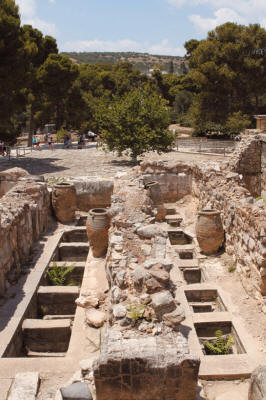
The palace at Knossos - the Minoan Empire mysteriously disappeared.
Some decades ago, certain natural scientists became intrigued by the
problem and, concentrating on the Bronze Age collapses listed above,
they realized that the range of evidence suggested natural causes
rather than human actions (invasion, warfare).
So, they all started talking about
climate change, volcanic activity, and earthquakes. At present,
these types of explanations are actually included in some of the
standard historical accounts of the Bronze Age period, though many
problems still remain: no single explanation appeared to account for
all the evidence.
Immanuel Velikovsky upset
everyone by suggesting that the Exodus - but only the Exodus - was
caused by a bombardment of rocks, dust, carbons, and so on, as a
result of Venus running amok in the Solar System. He collected an
amazing assortment of myths and legends from around the world that
strongly suggested that some sort of global cataclysm was being
described, but when, where and how exactly it happened was rather
iffy.
There were others who wrote and talked
about these matters before Velikovsky, including Ignatious
Donnelly, who deserves an honorable mention for ascribing the
myths to the Great Flood of Noah which he claimed was actually the
destruction of
Atlantis as described by Plato.
Whether or not there was an advanced
civilization known as Atlantis is not our concern here, but whether
or not there was a flood, and when it may have occurred, is.
In the late 1970s, British astronomers Victor Clube and
Bill Napier of Oxford University began investigating cometary
impact as the ultimate cause. In 1980, Nobel Prize winning physicist
Luis Alvarez and his colleagues published a paper in Science which
argued that a cosmic impact is what led to the extinction of the
dinosaurs.
Alvarez's paper had immense influence,
though that influence acted in different ways on the two sides of
the Atlantic.
In the US, there is the 'wishful
thinking' school which posits that only asteroid impacts are
significant and they are so rare that we don't have to worry. In
Britain, further research by astronomers Clube and Napier, Prof.
Mark Bailey of the Armagh Observatory, Duncan Steel of Spaceguard
Australia, and Britain's best known astronomer Sir Fred Hoyle,
all led to their support of the theory of cometary impact
loosely termed the 'British School of Coherent Catastrophism'.
According to Clube and Napier, et al., in the same way that Jupiter
was struck repeatedly in 1994 by the million-megaton impacts of the
comet Shoemaker-Levy, so Earth was
bombarded 13,000 years ago by the fragments of a giant comet that
broke up in the sky before the terrified eyes of humanity.
The multiple impacts on the rotating
planet caused tidal waves, raging fires, atomic bomb-like blasts,
the mass extinction of many prehistoric species such as the mammoth
and sabre-toothed tiger, most of humanity, and left the world in
darkness for months.
(See: The Cosmic Serpent
and The Cosmic Winter by Clube and Napier. See also: "The Origin of
the Universe and the Origin of Religion", Anshen Transdisciplinary
Lectureships in Art, Science, and the Philosophy of Culture by Fred
Hoyle.)
Some American scientists are joining the
Coherent Catastrophism group.
Physicist Richard Firestone and
geologists Allen West and Simon Warwick-Smith write in
their book,
The Cycle of Cosmic Catastrophes
(2006):
In 1990, Victor Clube, an
astrophysicist, and Bill Napier, an astronomer, published The
Cosmic Winter, a book in which they describe performing orbital
analyses of several of the meteor showers that hit Earth every
year. Using sophisticated computer software, they carefully
looked backward for thousands of years, tracing the orbits of
comets, asteroids, and meteor showers until they uncovered
something astounding.
Many meteor showers are related to
one another, such as the Taurids, Perseids, Piscids, and
Orionids. In addition, some very large cosmic objects are
related: the comets Encke and Rudnicki, the asteroids Oljato,
Hephaistos, and about 100 others. Every one of those 100-plus
cosmic bodies is at least a half-mile in diameter and some are
miles wide.
And what do they have in common?
According to those scientists, every one is the offspring of
the same massive comet that first entered our system less
than 20,000 years ago! Clube and Napier calculated that, to
account for all the debris they found strewn throughout our
solar system, the original comet had to have been enormous.
Clube and Napier also calculated that, because of subtle changes
in the orbits of Earth and the remaining cosmic debris, Earth
crosses through the densest part of the giant comet clouds about
every 2,000 to 4,000 years.
When we look at climate and ice-core
records, we can see that pattern.
For example, the iridium, helium-3,
nitrate, ammonium, and other key measurements seem to rise and
fall in tandem, producing noticeable peaks around 18,000,
16,000, 13,000, 9,000, 5,000, and 2,000 years ago. In that
pattern of peaks every 2,000 to 4,000 years, we may be seeing
the 'calling cards' of the returning mega-comet.
Fortunately, the oldest peaks were the heaviest bombardments,
and things have been getting quieter since then, as the remains
of the comet break up into even smaller pieces. The danger is
not past, however. Some of the remaining miles-wide pieces are
big enough to do serious damage to our cities, climate, and
global economy.
Clube and Napier (1984) predicted
that , in the year 2000 and continuing for 400 years, Earth
would enter another dangerous time in which the planet's
changing orbit would bring us into a potential collision course
with the densest parts of the clouds containing some very large
debris.
Twenty years after their prediction,
we have just now moved into the danger zone.
It is a widely accepted fact that
some of those large objects are in Earth-crossing orbits at this
very moment, and the only uncertainty is whether they will miss
us, as is most likely, or whether they will crash into some part
of our planet.
And so we see that this new type of
'natural disaster' is beginning to be regarded by many scholars as
the most probable single explanation for widespread and simultaneous
cultural collapses at various times in our history.
These ideas have been advanced largely
by astronomers and geologists, dendrochronologists, etc., and remain
almost completely unknown among archaeologists and historians, which
significantly hampers their efforts to explain what they may be
seeing in the historical record.
The new theory posits trains of cometary debris which repeatedly
encounter the Earth. We know most of these trains as meteor showers
- tiny particles of cosmic material whose impact is insignificant.
Occasionally, however, in these trains of debris, there are chunks
measuring between one and several hundred meters in diameter.
When these either strike the Earth or
explode in the atmosphere, there can be catastrophic effects on our
ecological system.
Multi-megaton explosions of fireballs
can destroy natural and cultural features on the surface of the
Earth by means of tidal-wave floods (if the debris lands in the
sea), fire blasts and seismic damage leaving no crater as a trace,
just scorched and blasted earth.
In the case of a significant
bombardment, an entire small country could be wiped out, completely
vaporized.
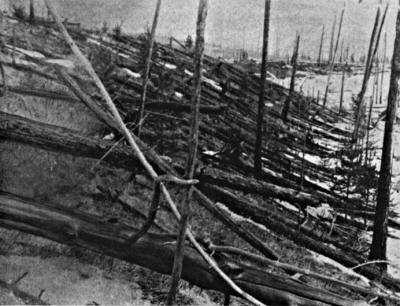
Trees were knocked down and burned over hundreds of square km
by the Tunguska
meteoroid impact.
A recent example, known as
the Tunguska Event, occurred in
1908 over Siberia, when a bolide exploded about 5 km above ground
and completely devastated an area of some 2,000 km² through fireball
blasts.
This cosmic body, thought to have
measured only 60 m across, had the impact energy of about 20 to 40
megatons, and was equivalent to the explosion of about 2,000
Hiroshima-size nuclear bombs, even though there was no actual
physical impact on the Earth. In other words, if there were ancient,
advanced civilizations, if they were destroyed by multiple
Tunguska-like events, it is no wonder there is no trace, or very
little, which is usually ascribed to 'anomaly'.
For years, the astronomical mainstream was highly critical of Clube
and Napier and their giant comet hypothesis.
However, the impacts of comet
Shoemaker-Levy 9 on Jupiter in 1994 led to a rather rapid turnaround
in attitude. The comet, watched by the world's observatories, was
seen to split into 20 pieces and slam into different parts of the
planet over a period of several days. A similar event vis-à-vis our
planet would have been devastating, to understate the matter.
In recent times, the increasing numbers
of fireballs and comets, the fact that Jupiter has been impacted yet
again and again just this year, suggests to us that Victor Clube and
Bill Napier are correct: we are in a very dangerous period.
In Rain of Iron and Ice by John Lewis, Professor of
Planetary Sciences at the Lunar and Planetary Laboratory,
Co-Director of the NASA/University of Arizona Space Engineering
Research Center, and Commissioner of the Arizona State Space
Commission, we learn that the earth is regularly hit by
extraterrestrial objects and many of the impacting bodies explode in
the atmosphere as happened in Tunguska, leaving no craters or
long-lasting visible evidence of a body from space.
These impacts or atmospheric explosions may produce
earthquakes or tsunamis
without any witnesses being aware of the cause.
After all, the earth is 75% water, and
any eye-witness to such an event would very likely be fried and
never tell about it, so we really have no way of knowing if all the
earthquakes on our planet are tectonic in nature or not.
In short, what the work of Lewis brings to the table is the idea
that some well-known historical earthquakes could very well have
been impact events. The dates that these researchers have given to
events that can be discerned in the scientific records are 12,800,
8,200, 5,200, and 4,200 BP ('years Before the Present'). These can
be adjusted as more precise dating methods are developed or applied.
The 12,800 B.P. event is the one of most interest because that is
the one which, apparently, nearly destroyed all life on earth. At
the very least, it destroyed the mega-fauna on all continents.
Plato wrote about the catastrophic
destruction of Atlantis which occurred in a day and a night about
11,600 years ago, which is pretty darn close. This event is the
topic Firestone, West and Warwick-Smith cover exhaustively in their
book The Cycle of Cosmic Catastrophes.
They include a great many Native
American myths that describe the event side by side with their own
scientific work on the evidence.
As already mentioned, Clube and Napier identified the progenitor of
the Taurid complex as a giant comet that was thrown into a
short-period (about 3.3 year) orbit sometime in the last twenty to
thirty thousand years.
The Taurid complex currently includes
the
Taurid meteor stream,
comet Encke, 'asteroids' such as
2101 Adonis and
2201 Oljato, and enormous amounts
of space dust.
Asteroids in the Taurid complex appear
to have associated meteor showers, which means that many asteroids
are likely to be extinct comets.
In other words, there can be more than
just some dust and snow in a comet - there can be a significant
rocky core and lots of poisonous gasses and chemicals as well.
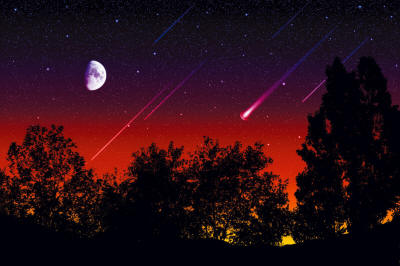
The Taurids…
We come now to the bit of evidence that may link between this comet
business and Halloween.
As it happens, the end of June and the
end of October/beginning of November are the times when the Earth
passes through the Taurid stream. That means that the event that
marked the boundary between the Pleistocene and Holocene (present
epoch) must have occurred at the end of October.
It was a day when the boundaries between
the living and the dead became very thin, because nearly every
living thing on this planet perished and the memory of this event
has come down to us in the 'End of Summer' commemoration we call
Halloween, known in the Bible as the Flood of Noah.
Where do the witches come in? Well, hang on, we are getting there.
Clube and Napier write:
...Meteor streams are fossil
evidence of past intersections with comet orbits... the major
streams are of great antiquity...
The progenitor of comet Encke and the Taurids, supposing it to
have been about 20 km in diameter, would, at its closest
approaches to the Earth, have attained a magnitude -12,
approaching that of the Moon and sufficient to throw shadows at
night.
It would have appeared as an intense
yellow spot of light surrounded by a circular coma probably
larger than the full Moon, with a tail stretching across a large
part of the sky... graduating from bluish white near the nucleus
to a deep red in color...
If the disintegration history
revealed by the current debris took place within the sight of
men, then there would have been occasions when subsidiary
comets, perhaps even an array, would have been observed...
There would (be) greatly enhanced
seasonal fireball activity, rising to enormous levels at
periodic intervals corresponding to a strong commensurability
between the orbital periods of Earth and Encke; and the risk of
Tunguska-like impacts would have been greatest.
In a periodic orbit, the close
approaches would obviously have been predictable. Indeed, if, at
these close approaches, the Earth ran into debris of the sort we
have discussed, prediction would have been a matter of
urgency...
The author of Genesis (15:17) wrote:
'When the sun went down, and it
was dark, behold a smoking furnace and a burning lamp...'
The description appears to be that
of a comet; but its representation is that of a vision of God
to Abraham.
Or again, in 1-Chronicles (21:16):
'And David lifted up his eyes,
and saw the angel of the Lord standing between the
earth and the heaven, having a drawn sword in his hand
stretched out over Jerusalem. Then David and the elders of
Israel, who were clothed in sackcloth, fell upon their
faces.'
Once more the object is seen as a
divine being, and 'angel of the Lord', and a religious
interpretation is placed on a natural phenomenon.
(Clube & Napier, 1982.)
Clube, Napier, Hoyle and others make a
good case for the origins of Judaism in celestial phenomena, later
twisted and distorted by priests into the superstition it is today.
Christopher Knight and Robert
Lomas wrote a fascinating book,
Uriel's Machine, about the
megalithic cultures wherein they propose that stone circles were
constructed as astronomical observatories that were not for the
purpose of knowing when to plant the corn, but rather to keep a
watchful eye on errant comets. They make a very good case.
The beginnings of Christianity may have been the result of similar
cosmic encounters.
Burton Mack writes:
"The story Josephus tells of the
sixties is one of famine, social unrest, institutional
deterioration, bitter internal conflicts, class warfare,
banditry, insurrections, intrigues, betrayals, bloodshed, and
the scattering of Judeans throughout Palestine...
There were wars, rumors of wars for
the better part of ten years, and Josephus reports portents,
including a brilliant daylight in the middle of the night!"
(Burton Mack, A Myth of
Innocence: Mark and Christian Origins, 1988, 2006)
Josephus gives several portents
of the evil to befall Jerusalem and the temple.
He described a star resembling a sword,
a comet that "continued a whole year...", a light shining in the
temple, a cow giving birth to a lamb at the moment it was to be
sacrificed in the Jerusalem Temple, armies fighting in the sky, and
a voice from the Holy of Holies declaring,
"We are departing" (Josephus, Jewish
Wars, 6). (Obviously, the voice was apocryphal.)
Some of these portents are mentioned by
other contemporary historians, Tacitus for example.
However, Tacitus, in book five of his
Histories, castigated the superstitious Jews for not recognizing
and offering expiations for the portents to avert the disasters. He
put the destruction of Jerusalem down to the stupidity or willful
ignorance of the Jews themselves in not offering the appropriate
sacrifices.
In short, it very well may be that the eschatological writings in
the New Testament, the very formation of
the Myth of Jesus, were based on
cometary events of the time, including a memory of the 'Star in the
East'.
The destruction of the Temple at
Jerusalem may very well have been an 'act of God', as reported by
Mark in his Gospel, though not quite as true believers think it was.
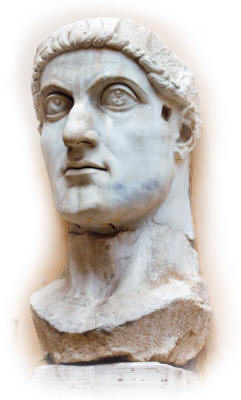
Jean-Christophe Benoist
Head of Constantine’s colossal statue.
This brings us, of course, to the transition: the imposition
of Christianity on Europe by Constantine.
Paul K. Davis writes:
"Constantine's victory gave him
total control of the Western Roman Empire, paving the way for
Christianity as the dominant religion for the Roman Empire and
ultimately for Europe."
It is commonly stated that on the
evening of 27 October, with the armies preparing for battle,
Constantine had a vision which led him to fight under the protection
of the Christian god.
The details of that vision, however,
differ depending on the source reporting it.
Lactantius, an early Christian writer of the time in
question, states that, in the night before the battle, Constantine
was commanded in a dream to,
"delineate the heavenly sign on the
shields of his soldiers".
(On the Deaths of the
Persecutors, 44.5).
He followed the commands of his dream
and marked the shields with a sign 'denoting Christ'.
Lactantius describes that sign as a 'staurogram',
or a Latin cross with its upper end rounded like a P. There is no
certain evidence that Constantine ever used that sign, opposed to
the better known
Chi-Rho sign described by Eusebius,
but it is certainly suggestive since it would look a bit like a
mushroom cloud.
New Scientist, (vol. 178, issue 2400, 21 June 2003, page 13)
reported the discovery of a meteorite impact crater dating from the
fourth or fifth century A.D. in the Apennines. The crater is now a
'seasonal lake', roughly circular, with a diameter of between 115
and 140 meters, which has a pronounced raised rim and no inlet or
outlet and is fed solely by rainfall.
There are a dozen much smaller craters
nearby, such as would be created when a meteorite with a diameter of
some 10 meters shattered during entry into the atmosphere.
A team led by the Swedish geologist Jens Ormo believes the
crater was caused by a meteorite landing with a one-kiloton impact -
equivalent to a very small nuclear blast - and producing shock
waves, earthquakes and a mushroom cloud. Samples from the crater's
rim have been dated to the year 312, but small amounts of
contamination with recent material could account for a date
significantly later than 312.
The legend of a falling star has been around in the Apennines since
Roman times, but the event that it describes has been a mystery.
Other accounts from the 4th
century describe how barbarians stood at the gates of the Roman
Empire while a Christian movement threatened its stability from
within. The emperor Constantine saw an amazing vision in the sky,
converted to Christianity on the spot, and led his army to victory
under the sign of the cross.
But what did he see?
Could the impact of a meteorite hitting the Italian Apennines, or a
Tunguska-like overhead cometary explosion, have been the sign in the
sky that encouraged the Emperor Constantine to invoke the christian
God in his decisive battle in 312, when he defeated his
fellow Emperor Maxentius at the Milvian Bridge?
The conversion of the Emperor to Christianity certainly couldn't
change the beliefs and practices of most of his subjects. But he
could - and did - choose to grant favors and privileges to those
whose faith he had accepted. He built churches for them, exempted
the priesthood from civic duties and taxes, gave the bishops secular
power over judicial affairs, and made them judges against whom there
was no appeal.
Sounds like how a Fascist regime takes
over, does it not?
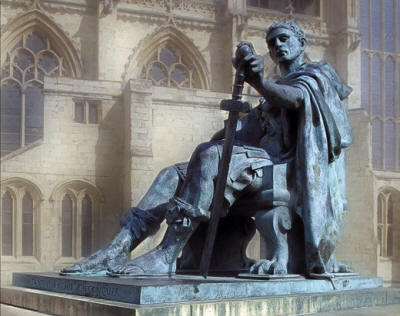
Gernot Keller
What did Constantine see in the sky circa 312?
So, let's recap here:
The god of the Jews leaped upon the
stage of history - probably as a cometary event that was
memorialized as the plagues in Egypt and recast as a heroic
'Exodus story'.
Through his priests, centuries after
the event when the reality of the 'god' was forgotten, this god
promised his people something new and different - destruction of
everybody else on the planet who were nasty to them - and only
those who followed his rules carefully would survive and get to
rule everybody else.
Notice that this did not necessarily
mean resurrection - it was to be a physical earthly
kingdom with the Jews in top position.
Early Christianity had very distinct and
novel ideas that were grafted onto Judaism.
Christianity, in turn, retained and
passed on in a virulent way certain ideals of Judaism which have
produced the foundation upon which our present culture is
predicated.
The main template of christianity - received directly from Judaism -
is that of sin. The history of sin from that point to now is
a story of its triumph. Awareness of the nature of sin led to a
growth industry in agencies and techniques for dealing with it.
These agencies became centers of economic and military power, as
they are today.
Christianity, promoting the ideals of Judaism under a thin veneer of
the 'New Covenant', changed the ways in which men and women
interacted with one another. It changed the attitude to life's one
certainty: death. It changed the degree of freedom with which people
could acceptably choose what to think and believe.
Pagan cults also dealt with the issues of suffering and troubles.
The big difference was that, to the pagans, troubles fell on a
person because they may have failed to propitiate the appropriate
god or goddess. Suffering and troubles were a consequence of the
actions of the gods - who were surprisingly human-like and fickle -
and were not a personal, internal 'flaw' that damned the individual.
Another big difference between Pagan cults and Monotheistic cults
was that Pagans were not committed to revealed beliefs in the strong
Christian sense. In other words, faith was neither endorsed nor
encouraged. Pagans performed rites, but professed no creed or
doctrine.
The rites included detailed rituals
involving the offering of animal victims to their gods, but there
was nothing like the 'faith' of Judaism or Christianity.

Judaism and Christianity brought the concept of ‘sin’.
To be a 'follower of pagan religion',
one did not have to accept the philosophic theology, nor did he have
to belong to a 'mystery cult' where myth and ritual were closely
entwined. These were just 'options'.
What the myths actually did was
confirm man's constant awareness of the potential anger of the gods,
the uncertainties of Nature. Pausanias, a Greek geographer of
the 2nd century AD, did not accept the outlandish stories
of mythology. But there was one thing that Pausanias was sure about:
the tales of the past anger of a god which had manifested in famines
and earthquakes and cataclysm.
He reminds us of how fragile
civilization is against the constant dangers of geology and the
weather.
And so it was, to 'follow pagan religion' was essentially to accept
this tradition of the past anger of the gods expressed in the
violence of nature, and that the gods could be appeased. And it was
precisely this fear of nature itself - of the gods that expressed
themselves in the forces of nature - that caused the pagans to
reject the Jews and Christians for claiming that they were immune to
such things because their god had power over nature and would save
them from calamity.
This brings us to another difference between the ancient myths and
cults and Judaism, Christianity and Islam: where the pagan cults
offered myths of their gods, Jews and Christians produced a recent,
living history. The pagan cults had 'mysteries' to which very few -
if anyone at all - had access. Monotheism offered a 'revelation'
direct from God.
Never mind that the history consisted of
the plagiarized myths of other cultures that had been dressed in
historical clothing as the 'History of Israel'.
Pagans had been intolerant of the Jews and Christians whose
religions tolerated no gods but their own. The rising domination of
Christianity created a much sharper conflict between religions, and
religious intolerance - incepted by Christianity - became the norm,
not the exception.
Christianity brought the open coercion
of religious belief. You could even say that, by the modern
definition of a cult as a group that uses manipulation and mind
control to induce worship, Christianity is the Mother of all Cults -
in service to the misogynistic, fascist ideals of Judaism.
The rising Christian hierarchy of the Dark Ages was quick to
mobilize military forces against believers in other gods and, most
especially, against other Christians who promoted less fascist
systems of belief. This probably included the original Christians
and the original teachings. One wonders, of course, about all the
stories of Christian martyrs.
Is it possible that these were
apocryphal stories of pagans who resisted the imposition of
Christianity with the details changed just a bit?
Meanwhile, there was a third group of individuals during the
transition time: the pagan Platonists.
There were two paths of Platonists:
These two ideas became the property of
the educated man of the time, including Jews and early Christians.
However, it was among the intellectual
Jews of Alexandria that these ideas were given a subtle twist:
a man could not know himself and
thereby know god, he must give up any idea of ever knowing
himself and resign himself to the 'grace' of god. God might
choose a man and apply grace, but man must never think he could
choose god and achieve grace.
The Christian theologians took this idea
and sculpted it to fit their new ideas of Christ and Redemption.
Many pagan ideas were adopted into Christian theology, but the chief
difference was, as I have noted, the idea of sin being a personal
thing, a personal fault, a sort of 'scapegoat principle' writ on the
human soul. The pagans never considered it necessary to die with
one's sins forgiven, and the dramatic deathbed scenes of
Christianity, with all the praying for the afterlife of the
individual, were novel and rapidly spread.
Pagans had prayed to the dead, Jews and
Christians prayed for them.
Fearing their own inevitable fault and
sinful nature, Christians also prayed that the dead would intercede
with god on their behalf. Christians, like pagans, continued the
practice of feasting and celebrating death, with the added element
of 'intercession' giving new meaning to the event.
Further along, there was another event in the Pagan world of Europe
that helped bring Christianity to dominance in the West of Europe,
and brought another player onto the stage: Islam.
"It was a warm, clear afternoon in
the capital. The bustle of metropolitan commerce and tourism
filled the streets.
Small sailing vessels dotted the
sheltered waters within sight of the government buildings,
riding on a soft southerly breeze. The Sun sparkled on the
gentle swells and wakes, lending a luminous glow to the poppies
and tulips nodding in the parks along the water's edge. All was
in order.
But suddenly, the sky brightened as if with a second, more
brilliant sun. A second set of shadows appeared; at first long
and faint, they shortened and sharpened rapidly. A strange
hissing, humming sound seemed to come from everywhere at once.
Thousands craned their necks and looked upwards, searching the
sky for the new Sun. Above them a tremendous white fireball
blossomed, like the unfolding of a vast paper flower, but now
blindingly bright.
For several seconds the fierce
fireball dominated the sky, shaming the Sun. The sky burned
white-hot, then slowly faded through yellow and orange to a
glowering copper-red. The awful hissing ceased. The onlookers,
blinded by the flash, burned by its searing heat, covered their
eyes and cringed in terror.
Occupants of offices and apartments
rushed to their windows, searching the sky for the source of the
brilliant flare that had lit their rooms. A great blanket of
turbulent, coppery cloud filled half the sky overhead. For a
dozen heartbeats the city was awestruck, numbed and silent.
Then, without warning, a tremendous blast smote the city,
knocking pedestrians to the ground. Shuttered doors and windows
blew out; fences, walls, and roofs groaned and cracked.
A shock wave raced across the city
and its waterways, knocking sailboats flat in the water. A hot,
sulfurous wind like an open door into hell, the breath of a
cosmic ironmaker's furnace, pressed downward from the sky,
filled with the endless reverberation of invisible landslides.
Then the hot breath slowed and paused; the normal breeze resumed
with renewed vigor, and cool air blew across the city from the
south.
The sky overhead now faded to dark
gray, then to a portentous black.
A turbulent black cloud like a
rumpled sheet seemed to descend from heaven. Fine black dust
began to fall, slowly, gently, suspended and swirled by the
breeze. For an hour or more the black dust fell, until,
dissipated and dispersed by the breeze, the cloud faded from
view.
Many thought it was the end of the world..."
The above quote is a reconstruction of
events in Constantinople, AD 472, extracted from Rain of Iron and
Ice (1996) by John S. Lewis.
According to Dr. Lewis, whose fanciful
scenario of what it might be like to witness an overhead cometary
fragment explosion, our Earth actually experiences these types of
events rather often, even if somewhat irregularly. Explosions in the
sky - some of them enormous - have, according to him and many other
scientists, profoundly affected the history of humanity.
One obvious prospect is the great
Antioch earthquake of AD 526 which was described by John Malalas:
"...those caught in the earth
beneath the buildings were incinerated and sparks of fire
appeared out of the air and burned everyone they struck like
lightning. The surface of the earth boiled and foundations of
buildings were struck by thunderbolts thrown up by the
earthquakes and were burned to ashes by fire...
It was a tremendous and incredible
marvel with fire belching out rain, rain falling from tremendous
furnaces, flames dissolving into showers... As a result, Antioch
became desolate... In this terror up to 250,000 people
perished."
(E. Jeffreys, M. Jeffreys and R.
Scott. The Chronicle of John Malalas. 1986, Melbourne: Byzantina
Australiensia, Australian Assoc. Byzantine Studies 4.)
Strangely, historians, as a group, don't
speak about such things.
But the evidence is mounting:
"Analysis of tree rings shows that
in 540 AD in different parts of the world, the climate changed.
Temperatures dropped enough to hinder the growth of trees as
widely dispersed as northern Europe, Siberia, western North
America, and southern South America.
A search of historical records and mythical stories pointed to a
disastrous visitation from the sky during the same period, it is
claimed. There was one reference to a 'comet in Gaul so vast
that the whole sky seemed on fire' in 540-41.
According to legend, King Arthur died around this time, and
Celtic myths associated with Arthur hinted at bright sky Gods
and bolts of fire.
In the 530s, an unusual meteor shower was recorded by both
Mediterranean and Chinese observers. Meteors are caused by the
fine dust from comets burning up in the atmosphere. Furthermore,
a team of astronomers from Armagh Observatory in Northern
Ireland published research in 1990 which said the Earth would
have been at risk from cometary bombardment between the years
400 and 600 AD...
"Famine followed the crop failures, and hard on its heels
bubonic plague that swept across Europe in the mid-6th
century.
... At this time, the Roman emperor Justinian was attempting to
regenerate the decaying Roman empire. But the plan failed in 540
and was followed by the Dark Ages and the rise of Islam."
(Robert S. Boyd. "Comets may have
caused Earth's great empires to fall." Knight-Ridder Newspapers,
August 17, 1999)
The change of the Western world from
Pagan to monotheistic -
Judaism, Christianity, Islam -
effectively changed how people viewed themselves and their
interactions with their reality.
And we live today with the fruits of
those changes: war without end.
Constantine's victory paved the way for
the recognition of Christianity by the Roman Empire and the union of
church and state that lasted for nearly 1,500 years and may, in
fact, still be strange bedfellows though they have pulled up the
covers to hide their relationship.
An inscription quoting an ancient
Hittite king informs us that a great prince needs the priests to
instill the fear of the gods into the people so that they will do
the will of the king, and the religion needs the protection of the
ruler to impose its practice. So it has been for millennia.
Astronomers Victor Clube and
Bill Napier write:
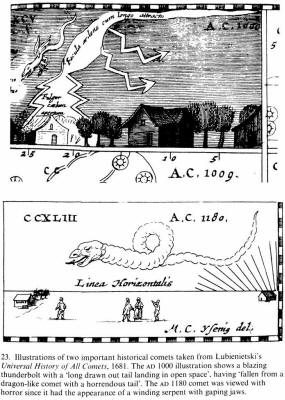
Illustrations of two important
historical comets
taken from Lubienietski’s Universal History of
All Comets, 1681.
The 1000 A.D. illustration shows a
blazing thunderbolt with a ‘long drawn out tail landing in open
space’, having ‘fallen from a dragon-like comet with a
horrendous tail’. The 1180 A.D. comet was viewed with horror
since it had the appearance of a winding serpent with gaping
jaws.
"...[W]ithin these last few years, it has been found that there
is a great swarm of cosmic debris circulating in a potentially
dangerous orbit, exactly intersecting the Earth's orbit in June
(and November) every few thousand years. More surprisingly,
perhaps, it has been found that the evidence for these facts was
in the past deliberately concealed.
When the orbits exactly intersect,
however, there is a greatly increased chance of penetrating the
core of the swarm, a correspondingly enhanced flow of fireballs
reaching the Earth, and a greatly raised perception that the end
of the world is nigh. This perception is liable to arise at
other times as well, whenever fresh debris is formed, but deep
penetrations occurred during the fourth millennium BC, again
during the first millennium BC, taking in at their close the
time of Christ, and will likely take place yet again
during the millennium to come.
Christian religion began appropriately enough, therefore, with
an apocalyptic vision of the past... once the apparent danger
had passed, truth was converted to mythology in the hands of a
revisionist church, and such prior knowledge of the swarm as
existed, which now comes to us through the works of Plato and
others, was later systematically suppressed.
...The Christian vision of a permanent peace on Earth was by no
means universally accepted, and it was to undergo several stages
of 'enlightenment' before it culminated with our present secular
version of history, to which science itself subscribes,
perceiving little or no danger from the sky. The lack of danger
is an illusion, however, and the long arm of an early Christian
delusion still has its effect.
...The idea of a terrible sanction hanging over mankind is not,
of course, new. Armageddon has been widely feared in the past,
and it was a common belief that it would arrive with the present
millennium... Sometimes the proponents of such ideas escape to
newfound new lands where in due course they meet opposition of a
homegrown kind.
In the United States, for example,
despite freedom of speech, old traditions of cosmic catastrophe
have recurred from time to time, even in the present century,
only to be confronted by Pavlovian outrage from authorities.
That being the case, it is perhaps ironic that elections in the
United States are generally held in November, following the
tradition of an ancient convocation of tribes at that time of
the year, which probably had its roots in a real fear of
world-end as the Earth coincided with the swarm.
In Europe, the millennium was finally dispensed with when an
official 'providential' view of the world was developed as a
counter to ideas sustained during the Reformation. Indeed, to
hold anything like a contrary view at this time became something
of a heresy and those who were given to rabble-rousing for fear
of the millennium were roundly condemned.
To the extent that a cosmic winter
and Armageddon have aspects in common, therefore, authoritarian
outrage is nothing new.
...Enlightenment, of course, builds on the providential view and
treats the cosmos as a harmless backdrop to human affairs, a
view of the world which Academe now often regards as its
business to uphold and to which the counter-reformed Church and
State are only too glad to subscribe. Indeed, it appears that
repeated cosmic stress - supernatural illuminations - have been
deliberately programmed out of Christian theology and modern
science, arguably the two most influential contributions of
western civilization to the control and well-being of humanity.
As a result, we have now come to think of global catastrophe,
whether through nuclear war, ozone holes, the greenhouse effect
of whatever, as a prospect originating purely with ourselves;
and because of this, because we are faced with 'authorities' who
never look higher than the rooftops, the likely impact of the
cosmos figures hardly at all in national plans.
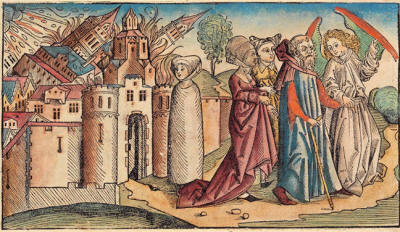
An image from ‘The Nuremburg Chronicles’, 1493.
A great illusion of cosmic security
thus envelops mankind, one that the 'establishment' of Church,
State and Academe do nothing to disturb.
Persistence in such an illusion will
do nothing to alleviate the next Dark Age when it arrives. But
it is easily shattered: one simply has to look at the sky.
The outrage, then, springs from a singularly myopic stance which
may now place the human species a little higher than the
ostrich, awaiting the fate of the dinosaur."
(Clube and Napier. The Cosmic
Winter. 1990.)
An abundance of fireballs and repeated
comet sightings apparently excites a lot of 'eschatological
activity' - predictions that the world is going to end - that can
lead to all kinds of social unrest which is, as Clube points out,
highly undesirable to
the ruling elites.
After all, if people are thinking the
world is going to end, they generally blame it on their rulers for
being so corrupt and evil.
The way they usually handle that sort of
thing is to create an ostensible enemy who is responsible for it
all, get a war going that soothes everyone's 'end of the world
blues' and kills most of them in the bargain.
Clever, aren't they?
Victor Clube wrote a summary statement of conclusions based on his
Narrative Report on the Hazard to Civilization
Due to Fireballs and Comets, which he wrote under the
sponsorship of the US Air Force and Oxford Department of Physics
(1996, just two years after comet Shoemaker-Levy hit Jupiter), which
includes the following:
"Every 5-10 generations or so, for
about a generation, mankind is subject to an increased risk of
global insult through another kind of cosmic agency.
During these epochs, broadly
coinciding with the Hundred Years' War, the Reformation, the
Thirty Years' War (including the English Civil War), the French
Revolutionary Period (including the American War of
Independence) and the mid-nineteenth century Revolutionary
crisis in Europe (including the American Civil War), the various
national authorities could do very little to restrain public
anxiety in the face of the perceived danger."
Every 5 to 10 generations?
That's a pretty shocking statement. If
it is true, then why don't we know about this? Why don't historians
know about it? Why don't average people who learn history (one is
told) in school know about these things?
It is here that we are going to discover how witches came to be
associated with Halloween.

Historical evidence for recent earth-changing comet impacts is
profuse.
The Hundred Years War covers the 116-year period from 1337 to 1453,
the Black Death 1347/48-1351, and then the Renaissance, 1400 to
1600.
Some really ugly stuff was going on back
then. Dendrochronologist Mike Baillie, has written a book
asserting (with good evidence) that the Black Death - one of the
most deadly pandemics in human history, said to have killed possibly
two thirds of the entire population of Europe, not to mention
millions all over the planet - probably wasn't Bubonic Plague but
was rather Death by Comet(s).
Baillie has the scientific evidence to support his theory, and his
evidence actually supports - and is supported by - what the people
of the time were saying:
earthquakes, comets, rains of death
and fire, corrupted atmosphere, and death on a scale that is
almost unimaginable.
Most people nowadays are not really
aware of what happened just 663 years ago. (Hmmm... The inquiring
mind immediately wonders what might happen when we hit 666 years
after? That would be 2013...)
There really is quite sufficient data
presented in Baillie's book to support the theory that the Black
Death was due to localized, multiple impacts by comet debris -
similar to the impacts on Jupiter by the fragments of comet
Shoemaker-Levy back in 1994.
As to exactly how these deaths occurred,
there are a number of possibilities: earthquakes, floods (tsunami),
rains of fire, chemicals released by the high-energy explosions in
the atmosphere, including ammonium and hydrogen cyanide, and
possibly even comet-borne disease pathogens. It is worth pausing a
moment to consider the numbers.
China, where the Black Death is said to have originated, lost around
half of its entire population (going from around 123 million to
around 65 million).
Recent research into European death
tolls also suggests a figure of 45% to 50% of the total European
population dying during a four-year period though the figure
fluctuated from place to place (which is a problem as we will see).
In Mediterranean Europe - Italy, the
South of France and Spain - where the plague ran for about four
years consecutively, it was probably closer to 70-75% of the total
population. (In the US today that would be equivalent to reducing
the population from its current 305 million to 75 million in less
than four years. That would also amount to having to bury or dispose
of around 225 million corpses.)
In Germany and England it was probably
closer to 20%. Northeastern Germany, Bohemia, Poland and Hungary are
believed to have suffered less for some reason (and there are a few
theories which are not entirely satisfactory).
There are no estimates available for Russia or the Balkans, so it
seems that they may have suffered little, if at all. Africa lost
approximately 1/8th of its population (from around 80
million to 70 million).
(These figures actually highlight one of
the problems that Baillie brings up: the variability of death rates
according to location.)
Whatever the death rate in any given
location, the bottom line is that the Black Death produced the
largest death toll from any known pandemics in recorded history and,
as Baillie points out, nobody really knows what it was.
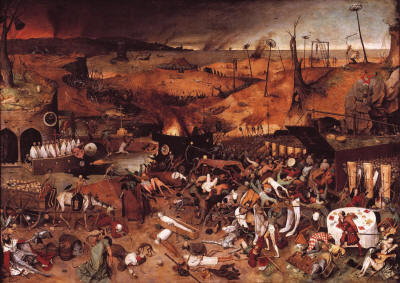
Social upheaval and terror at the time of the ‘black death’ and the
‘hundred years war’.
(Pieter Bruegel the
Elder. “The Triumph of Death”, ca. 1562. Museo del Prado, Madrid,
Spain.)
In Hazard to Civilization from Fireballs and Comets cited
above, Victor Clube adds:
"Confronted on many occasions in the
past by the prospect of world-end, national elites have often
found themselves having to suppress public panic - only to
discover, too late, that the usual means of control commonly
fail.
Thus, an institutionalized science
is expected to withhold knowledge of the threat; a
self-regulated press is expected to make light of any disaster;
while an institutionalized religion is expected to oppose
predestination and to secure such general belief in a
fundamentally benevolent deity as can be mustered.
... The Christian, Islamic and Judaic cultures have all moved
since the European Renaissance to adopt an unreasoning
anti-apocalyptic stance, apparently unaware of the burgeoning
science of catastrophes. History, it now seems, is repeating
itself: it has taken the Space Age to revive the Platonist voice
of reason, but it emerges this time within a modern
anti-fundamentalist, anti-apocalyptic tradition over which
governments may, as before, be unable to exercise control...
Cynics (or modern sophists), in
other words, would say that we do not need the celestial threat
to disguise Cold War intentions; rather we need the Cold War to
disguise celestial intentions!"
Turning to the full text of the report,
on page 2, discussing potential impacting giant comet remnants, we
read that,
"...their presence is readily enough
betrayed by the zodiacal dust, which continues to accumulate in
the ecliptic, and by the rather sudden encounters which the
Earth makes every other century or so, for several decades...
These encounters produce an
overabundance of fireballs, penetrating the Earth's atmosphere,
implying both an increased probability of bombardment by
sub-kilometer debris and an increased risk that the Earth will
penetrate the core of a minor disintegration stream à la
Shoemaker-Levy."
The so-called 'Hundred Years War' was a
conflict between France and England, over claims by the English
kings to the French throne.
It was punctuated by several brief and
two lengthy periods of peace before it finally ended in the
expulsion of the English from France, with the exception of the
Calais Pale.
We notice that this state of conflict
was already in motion about ten years before the Black Death fell on
Europe.
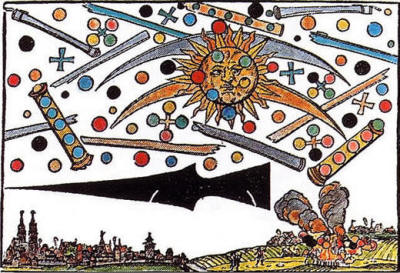
A woodcut by Hans Glaser (1566)
showing a strange
celestial event in 1561 over Nuremberg.
When one studies the history of
the Black Death and
the Hundred Years War side by side,
the thing that stands out is that whatever was going on then, there
were conscienceless people taking advantage of the situation of
confusion and terror.
For example, we read the following:
This would be a war of devastation.
Villages and crops were burned, orchards were felled, livestock
seized and residents harried. On Edward's entry into France he
spent a week torching Cambrai and its environs. More than 1,000
villages were destroyed.
France did what it could in England,
at the war's onset seamen ventured to the southeastern coast of
England to burn and ravage there. Much plunder was taken back to
England and the thought of acquiring ill-gotten gain enticed
many to support the war.
Cruelty abounded. After the city of Limoges was captured and
burned, Edward ordered the townsmen executed. Much of Artois,
Brittany, Normandy, Gascony and other provinces were reduced to
desolation (circa 1355 to 1375) and France did the same to the
provinces that sided with England.
Walled towns were safe during the
early period of the war, but churches, monasteries, villages and
rural areas were ruined.
Truce and treaty were not observed. The 'Free Companies' went
into action, bandits of either English, French or hired
mercenaries led by captains that dominated large areas and
levied tribute on towns, villages and churches.
They also seized women, took
clergymen as accountants and correspondents, children for
servants and plundered.
(Edward P. Cheney. The Dawn of a
New Era. 1250-1435. 1936.)
Albert A. Nofi and James F.
Dunnigan tell us:
For the first few years of the war
there wasn't much happening except English raids into France and
Flanders. Then, in the 1340s, England and France took opposite
sides in the long-running civil war over who should be the duke
of Brittany.
In 1346 this resulted in a French
invasion of Gascony and the shattering French defeat at Crecy.
The English then rampaged through western France, until a truce
was signed in 1354 (brought on by the devastation of the Plague,
which hit France heavily in 1347-48)
The truce didn't last. In 1355, the war began again. In 1356
another major battle was fought at Poitiers and the French king
was captured. English raids continued until 1360, when another
truce was signed.
One wonders if all this is not history
written after the fact, placing the blame of cometary destruction
and social unrest on a 'hundred years war'? As evidence to support
this, it seems that the weather was going crazy.
Clube and Napier write:
One chronicler at least reports of
the most immediate cause of the plague in 1345 that,
'between Cathay and Persia there
rained a vast rain of fire; falling in flakes like snow and
burning up mountains and plains and other lands, with men
and women; and then arose vast masses of smoke; and
whosoever beheld this died within the space of half a
day...'
There seems little doubt also that a
worldwide cooling of the Earth played a fundamental part in the
process. The Arctic polar cap extended, changing the cyclonic
pattern and leading to a series of disastrous harvests. These in
turn led to widespread famine, death and social disruption.
In England and Scotland, there is a pattern of abandoned
villages and farms, soaring wheat prices and falling
populations.
In Eastern Europe there was a series of winters of unparalleled
severity and depth of snow. The chronicles of monasteries in
Poland and Russia tell of cannibalism, common graves overfilled
with corpses, and migrations to the west.
Even before the Black Death came, then, a human catastrophe of
great proportions was under way in late medieval times. Indeed,
the cold snap lasted well beyond the period of the... plague.
A number of such fluctuations are to
be found in the historical record, and there is good evidence
that these climatic stresses are connected not only with famine
but also with times of great social unrest, wars, revolution and
mass migrations.
(Clube, The Cosmic Winter.)
It sounds surprisingly like our own era,
does it not?
There are differences in detail and in
scale, but the dynamics of a world gone mad, incredible cruelty
running rampant, and global climate fluctuations are the same as we
see before us now.
Calvinism was one of the developments that came out of this period.
As Clube notes, the Protestant reformation was partly due to the
fact that the powers of the time, the Catholic Church, had built
their control system based on the Aristotelian system of,
'God is in his heaven and all
will be right with the world if you are a good Christian'.
Obviously, they didn't want to talk
about a cosmos run amok over which their vaunted god had no control.
And the fact that things were running
amok and the church couldn't do anything about it (not to mention
the corruption of the church that was evident to the masses) gave
ammunition to the Reformers who then were able to attract many
followers just as Christianity attracted Constantine at a time when
the pagan gods did not seem to be able to help in the face of
cometary bombardment.
The Protestants thus were able to use the situation to their
advantage, suggesting that it was 'The End of Times' and that this
was all part of the plan and people would be saved if they would
only come over to the Protestant side.
Of course, once the Protestants had 'won their place', so to say,
they too had to establish authority and adopt the Aristotelian view!
'Now, God is in his heaven
and all will be right and there won't be any more catastrophic
disruptions as long as everybody goes to church, tithes, and
obeys the appointed authorities.'
This brings us to the topic of witch
persecutions.
From the early decades of the fifteenth
century until 1650, continental Europeans executed between two and
five hundred thousand witches (according to conservative estimates),
more than 85 percent of them being women. (Ben-Yehuda, 1985.) People
of the time, and even later, really did believe in the reality of
witchcraft and evil demons.
Men like Newton, Bacon, Boyle, Locke and
Hobbes firmly believed in the reality of evil spirits and witches.
As historian and religious scholar
J.B. Russell said:
Tens of thousands of [witch] trials
continued throughout Europe generation after generation, while
Leonardo painted, Palestrina composed and Shakespeare wrote.
(1977.)
Witchcraft and witches have existed
throughout history though in a context completely different from
that which came to be understood during the crusade against witches.
The Old Testament pretty much ignores
the topic, except to report an encounter between King Saul and the
witch of Endor, and to include a law:
"Thou shalt not suffer a witch to
live".
But other than that, in a way that seems
to bizarrely contradict that law, stories of witches in the Bible
are surprisingly neutral.
There is no conceptualization or
elaboration of witches, devils, or any kind of demonic world. The
world of the Old Testament is, in fact, a world surprisingly devoid
of anything truly spiritual.
In ancient Greece and Rome, magic was used to produce rain, prevent
hail storms, drive away clouds, calm the winds, make the earth bear
fruit, increase wealth, cure the sick, and so on. It could also be
used against one's enemies to deprive them of those desirable
effects.
These beliefs were widespread in the
ancient world influenced by Pythagoras and his Northern
European Druidic training, and generally,
'good magic' was lawful and
necessary, and 'bad magic' was condemned and punished.
The state even supported those who could
purportedly do 'good magic'.
It depended on perspective whether you
were a 'good magician' or a 'bad' one. That's probably why the
English condemned Joan of Arc for being a witch and France turned
around and canonized her.
The Greco-Roman religious universe - the supernatural world - was
not divided into extreme good and extreme evil. It was occupied by
every shade and combination of all qualities exactly as existed in
human society.
In this world, magic was simply an
attempt to harness the power of the Unseen, while religion occupied
itself with respect and gratitude to Nature and its representatives
for results. In this way, prayers and spells could be easily
combined.
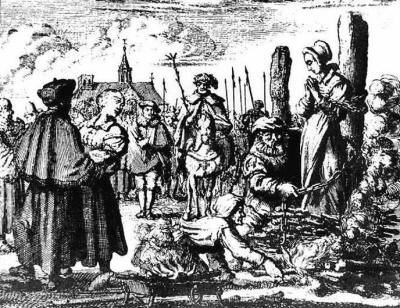
A ‘witch’ being
burned at the stake
The witch or sorcerer was a person who
had a method - a technology - that could be used to harness and
activate supernatural powers for her/himself or for others. She/he
could 'control' the forces of nature.
(At least, that is what they believed,
and who are we to say that the truly ancient shamanic technicians
couldn't?)
So, two points are important here:
-
witchcraft/sorcery was a
technology
-
there was a definite distinction
between good magic and bad magic, and context was
all-important
After the disintegration of the Roman
Empire and the rise of Judeo-Christianity, many missionaries, on
finding that the pagans had their own spectrum of local deities and
beliefs, often sought to convert them by the simple expedient of
canonizing the local gods so that the native population could
continue to worship them under the aegis of Christianity.
They became 'Christian saints' complete
with invented hagiographies (as I mentioned above, possibly most
'Christian Martyrs' were actually pagans killed by the church). The
old temples were converted into churches so that the pagans would
come to familiar places of worship to hear mass and pray to their
'saints' just like always.
Magical practices were tolerated because
it was felt that the people would give them up naturally over time
once they had become truly Christian. Official church policy held
that any belief in witchcraft was an illusion.
In the famous, but mysterious,
Canon episcopi, we find a few
clues:
Some wicked women, perverted by the
devil, seduced by illusions and phantasms of demons, believe and
profess themselves in the hours of night, to ride upon certain
beastes with Diana, the goddess of pagans, and an innumerable
multitude of women, and in the silence of the dead of night to
traverse great spaces of earth, and to obey her commands as of
their mistress, and to be summoned to her service on certain
nights.
But I wish it were they alone who
perished in their faithlessness and did not draw many with them
into the destruction of infidelity. For an innumerable
multitude, deceived by this false opinion, believe this to be
true, and so believing, wander from the right faith and are
invalued in the error of the pagans...
Wherefore the priests throughout their churches should preach
with all insistence... that they know this to be false and, that
such phantasms are imposed and sent by the malignant spirit...
who deludes them in dreams...
Who is there who is not led out of himself in dreams, seeing
such in sleeping which he never sees [when] waking?
... And who is so stupid and foolish as to think that all these
things, which are only done in spirit, happen in the body?
It is therefore to be proclaimed publicly to all that whoever
believes such things... has lost his faith.
(Translated by Kors and Peters,
1972, pp. 29-31.)
The origin of this document, that Kors
and Peters date to 1140, is not clear. It has been attributed to an
obscure meeting, the Council of Anquira, held possibly in the 4th
century.
Although there is no record of this
council, the statement on witchcraft was adopted by later canonists
as official policy. What it does tell us is that there were,
apparently, worshippers of the Pagan Goddess Diana who had profound
experiences that were declared to be delusions brought on by the
Devil.
Right here we see how the Goddess was
replaced by Satan the deluder. It is interesting to compare the
description of what these ancient witches were said to be doing with
the activities of ancient Siberian shamans.
One is also reminded of the Paleolithic
cave paintings when reading,
"in the hours of night, to ride upon
certain beastes with Diana, the goddess of pagans..."
This is a precious clue to the fact that
the Paleolithic religion and its shamanic lines did survive for
thousands of years.
In any event, for more than six centuries this was the official
attitude of the church toward witches - that it was an illusion or
delusion or just the product of dreams, and whoever was "so stupid
and foolish" as to believe such fantastic tales was an infidel.
That, apparently, applied to monks, and priests, and the general
public as well.
The important point here being that you
had to believe in witches to persecute them, and believing in them
as real was against church doctrine.
Taking into account the Black Death and the wars of the time killing
off so much of the male population, one might suppose that there was
an increase in unmarried women or women who had inherited estates
when all other family members had perished. In short, women were
becoming autonomous as a consequence.
And certainly, women who had 'gifts'
would be more likely to survive such calamities than those who did
not.
The details of exactly what happened may be forever lost to us
thanks to the cover-up of history instituted by Joseph Justus
Scaliger in the sixteenth century as has been suggested by Clube and
revealed in some detail by mathematician Anatoly Fomenko
(though Fomenko does not take catastrophic destruction of society
into account).
The best we can do is to speculate.
The most spectacular 'witch' was Joan of Arc who was tried,
condemned, and burned in 1431. Her trial and execution can clearly
be seen as political, often a major, underlying motivation for such
accusations. It could be said that the witch persecutions were
simply a reviving of the Inquisition that had created similar rules
for dealing with
the Cathars two hundred years
earlier.
In order to fully understand how easily
this attack on 'witches and sorcerers' could manifest legally and
socially, we need to take a quick look at the beginnings of the
Inquisition.
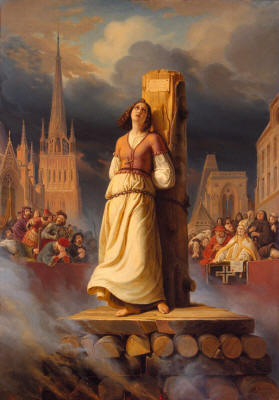
Joan of Arc as depicted by Hermann Stilke (1803-1860).
Many people think of the inquisition as something that was started
to eliminate witches and Devil worship, and the word conjures
images of the rack and iron maidens and all kinds of bizarre and
twisted torture equipment.
Sure, torture was a big part of the
Inquisition, but not as much as some people might think. You have to
remember that the Inquisition began during a period of history when
human life was treated so casually that cutting off noses or ears or
hands, or gouging out eyes was not unheard of as a legal punishment
for minor crimes.
The Crusade against the Cathars led to years of brutal massacres,
destruction of the land, and some of the most horrible events ever
to bear witness of man's inhumanity to man. Toward the end, Pope
Gregory IX decided that it was only results that counted. He
intended to wipe Catharism from the face of the earth. He must have
sat up at night to create the bizarre system that was put into place
to deal with heresy.
First, he created special Papal legates who were granted wide powers
of prosecution similar to what we have today in the Department of
Homeland Security, and sent them out all over Europe.
The men chosen for this task were
clearly psychopaths, and their mission was to spread
terror all over Europe.
Gregory staffed the Episcopal palaces of the South of France with
psychopathic bishops who offered a cash bounty to anyone who
betrayed a heretic. The inducements to betray one's neighbor were
surely tempting in the best of times. But in a time when starvation
and destruction was everywhere after more than 20 years of the
rampaging of the Crusading armies, it was well-nigh impossible to
resist.
The terms were that the property
confiscated from the heretic was divided between the informer, the
church and the crown. Naturally, in a land that was financially
devastated, where people were displaced and starving after years of
being battered by this same church and crown, there were a lot of
individuals offering up their neighbors for blood money.
Sound familiar?
Robert le Bourgre, whose name means 'the bugger' (suggesting
the contempt in which he was held by the people), terrorized
formerly peaceful northern France. Another legate, Conrad of
Marburg found unsuspected heretics everywhere in the Rhineland.
Thousands were sent to the stake, often
on the same day that they were accused. Conrad rode about on his
mule with two assistants, bringing terror to every village and town
they approached. Apparently, even the regular clergy saw through
this nonsense and finally decided to do something about it. On July
30, 1233, a Franciscan friar, driven to act in the name of justice,
intercepted Conrad and murdered him.
The pope had had enough. He turned to the Dominicans. In the spring
of 1233, Papal inquisitors were appointed in Toulouse, Albi, and
Carcassonne.
These inquisitors were succeeded in
an unbroken line for 600 years.
Hundreds of people were summoned to testify before inquisitors. The
questions were repetitive, designed to plant doubt in the mind of
the person being interrogated as to what, exactly, the inquisitor
knew, and who had told him.
A person suspected of Cathar sympathies was not always
informed of the charges hanging over his head. If apprised of the
danger, he had no right to know who his accusers were, and if he
dared to seek legal help, his lawyer could be charged with abetting
heresy.
Whatever the verdict of the inquisitor - who was prosecutor, judge
and jury - no appeal was allowed. Anyone could be held indefinitely
in prison for further questioning without cause of explanation.
Nowadays, we call them 'enemy combatants'.
The inquisition destroyed the bonds of trust which hold societies
together. Informing on one's neighbor became not only a duty, but a
necessary survival strategy.
For 100 years,
the Inquisition was a fact on the
ground of life in the Languedoc. The arrival of an inquisitor in a
town was the occasion for demeaning displays of moral collapse.
In theory, of course, no one could be punished if no one talked
because the inquisitor could not act without a writ of denunciation,
but in practice, no community possessed the cohesion needed to
combat the power of a secret tribunal.
The same is true in America today.
Everyone has been adequately conditioned
by watching 'reality TV' and 'Survivor', and they know the rules:
Do unto others before they do unto
you.
And so it was in the Languedoc, the
historical model for the 'witch' persecutions, for what happened in
Germany under Hitler, and for what is happening in the world today
vis-à-vis the 'War on Terror'.
Upon his arrival in a town, the inquisitor consulted with the local
clergy. All males over the age of 14 and females over the age of 12
were required to make a profession of faith in
the Catholic Church. Those who didn't were the first to
be questioned.
Then the inquisitor would give a speech in which he invited the
people to spend some days thinking very, very hard about their
activities past, present and future and to come forward in the
following week to give confidential depositions. After a seven day
grace period, those who had not denounced themselves would be issued
a summons.
The punishments ranged from loss of property to loss of life. Aside
from the capital crime of being a Cathar, punishable offenses
included sheltering a Cathar or even failing to report any instance
of heresy.
The real proof of genuine piety toward the Catholic Church was
measured by the number of people the sinner was willing to betray.
It only took ten years for the Inquisition to go from being the work
of a few psychopathic fanatics to becoming a proficient bureaucracy
that lasted for 600 years. It employed hundreds of individuals who
interrogated thousands of people with such monotonous regularity
that a regular 'glossary' was established for the 'workers'.
Armed with a list of proposed offenses to be considered 'heretical'
or 'supporting heretics', which included just knowing that a heretic
had crossed one's property and failing to report it, the Inquisition
proceeded to intimidate the population of Europe on a scale that was
impossible to imagine. The sheer numbers of people called to
testify, and recalled to testify again and again, was staggering. In
a strange twist of historical irony, the Cathars - who believed that
the material world was evil and irrelevant - inspired the
codification of the Police State.
A cross-referenced compendium of the confessions extracted from tens
of thousands of people was compiled, creating a map of the mental
landscape of the Languedoc.
The more than five thousand transcripts
of interrogations that survive represent only a small fraction of
the work of
the Inquisition.
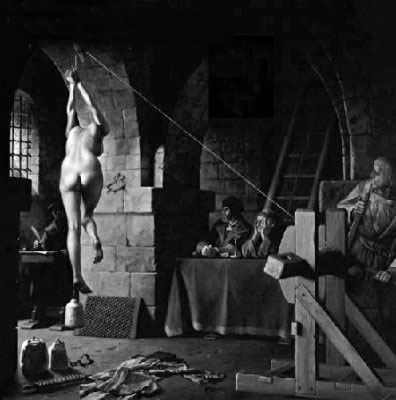
The inquisition
mercilessly tortured thousands of innocent people.
Inquisitors' manuals were created to
serve as guides for the growing number of Papal courts in Europe.
These manuals reminded the inquisitors
that they were in the business of saving souls, but I think that the
distinction was lost on those whose lives were lost or ruined by the
judgments of the Inquisition.
Languedoc was, essentially, the laboratory for repression. The
reputation of the Inquisition was enhanced by the talented
Inquisitor of Toulouse, Bernard Gui, who was the villain in Umberto
Eco's The Name of the Rose.
The Inquisitors persuaded a handful of captured Cathars to convert
and sell their testimony.
Sicard de Lunel of Albi gave the
friars an exhaustive list of Cathar sympathizers, even fingering his
own parents. Anyone who had ever helped him in his life as a Cathar,
whether they had just given him a bed for the night, a bit of food,
or even a jar of honey, were hauled in to be punished, just on his
word. He and several others like him were lodged thereafter in a
castle outside of Toulouse in the medieval version of the 'witness
protection program'.
Sicard was well paid for his perfidy and
lived to a ripe old age. One wonders how peaceful it was.
The use of torture was delicately referred to as 'putting the
question'. In the Languedoc, successive waves of highly trained
inquisitors, aided by informers and torturers, fired by the
totalitarian creed of the Catholic Church, with detailed manuals and
expanding registers of 'intelligence', slowly but surely ground
Catharism into oblivion.
Thousands of dramas of conscience ended
in the dungeons or in fires quenched with blood. By the end of the
century, only the truly heroic dared to say that this world was
evil.
It was not a legal system, it was a system designed to create fear.
This 250 years old Catholic system of terror was the
system that was handily available at the beginning of the witch
persecutions, though, curiously, the first persecutions were not
ecclesiastical but rather political.
In 1397, a man named Stedelen was accused of being a witch in
Simmental, Switzerland, after the harvest had failed at his village.
According to his accusers, Stedelen used black magic to destroy the
crops by allegedly sacrificing a black rooster on the Sabbath at a
crossroad and placing a lizard under the doorway of a local church.
Peter von Greyerz, the judge, was a firm believer in
witchcraft, which he believed had been introduced in Simmental by a
noble man called Scavius in 1375. He was killed by his many enemies,
but he had a student, who according to Greyerz had been the tutor of
Stedelen.
There was no real evidence presented, of course, but Stedelen had
allegedly become an expert on magic and supposedly learned to steal
manure, hay and such from others' fields by magic, create hail and
thunderstorms, make people and animals sterile, make horses crazy
when he touched their hooves, fly and terrify those who captured
him.
Greyerz also accused Stedelen of having
taken the milk from the cows of a married couple in order to make
the wife miscarry. After torture, Stedelen confessed to summoning
forth demons as part of a pact with the Devil. His trial took place
in a secular court following which he was burned at the stake.
Greyerz believed that there was a satanic cult, whose members swore
themselves to the Devil and ate children at the churches at night.
He continued his persecutions and once tortured a woman to confirm
this.
In 1415-1419, in the Duchy of Savoy, there was a civil-war between
clans of the nobility.
Various noble families had rebelled
against the Raron family, and the masses were drawn into the
conflict. This had gone on for some time and, by 1428, the entire
society in that area was in a state of great tension. No one knows
who came up with the idea that all the troubles were due to witches,
but on 7 August 1428, delegates from seven districts in Valais
demanded that the authorities investigate alleged, unknown witches
and sorcerers.
Anyone denounced as a sorcerer by more
than three people was to be arrested. If they confessed, they were
to be burned at the stake as heretics, and if they did not confess,
they would be tortured until they did so.
Also, those pointed out by more than two
of the judged sorcerers were to be arrested.
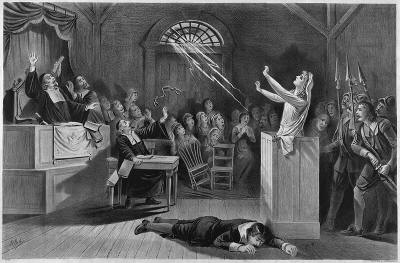
A fanciful interpretation of the Salem Witch Trials.
These accusations, trials and executions were probably seen by other
elite individuals - or individuals who wished to become members of
the elite by seizing the property of those they resented or envied -
as a handy way to deal with many problems.
The craze rapidly spread north into
Germany, then to France and Switzerland.
The main accusations consisted of:
-
flying through the air and
plundering wine cellars
-
lycanthropy - to have killed
cattle in the shapes of werewolves
-
to have made themselves
invisible with herbs
-
to have cured sickness and
paralysis caused by sorcery by giving it to someone else
-
to have abducted and eaten
children
-
to have met Satan and learned
magic from him
-
to have planned to deprive
Christianity of its power over humanity
From this list, we can surmise the kinds
of troubles that the people were suffering: starvation leading to
theft and vandalism, destruction of their livestock, widespread
sickness, loss of children, and, undoubtedly, even cannibalism.
It was clearly a very difficult time.
One hundred years after the black death had destroyed about half of
Europe's population, the Hundred Years' War was coming to an end,
things were still very, very difficult, and in order to restore
order and control on the recovering society someone had to be blamed
(definitely not cometary explosions).
The problem was, of course, how to get
around the
Canon episcopi. It was necessary to diminish this
official church policy in order to even have a 'witch craze'.
So, the first attacks were made on the
validity of the document itself.
-
In 1450, Jean Vineti, inquisitor
at Carcassone, identified witchcraft with heresy,
-
In 1458, Nicholas Jacquier,
inquisitor in France and Bohemia, identified it as a new
form of heresy - that is, contemporary witches were claimed
to be different from the ones that the document was about
-
In 1460, Visconti Girolamo,
inquisitor professor, Provincial of Lombardy, stated that
the act of defending witchcraft (or witches) was itself
heresy
Incremental steps were being made toward
establishing an official standard, but still, when Kramer and
Sprenger (both members of the Dominican Order and Inquisitors
for the Catholic Church) wrote
the Malleus Maleficarum and
submitted it to the University of Cologne's Faculty of Theology on
May 9, 1487, seeking its endorsement, it was roundly condemned as
unethical and illegal.
The Catholic Church banned the book in
1490, placing it on the Index Librorum Prohibitorum, and
Kramer was denounced by the Inquisition. It should be noted here
that, in 1484, Kramer had attempted a systematic persecution of
witches in the region of Tyrol which bombed dramatically. Kramer was
thrown out of the territory and dismissed by the local bishop as a
"senile old man".
According to historian of the church
Diarmaid MacCulloch, writing the book was Kramer's act of
self-justification and revenge.
The main thrust of the Malleus was to systematically refute the
Canon episcopi and to discredit those who expressed skepticism about
the reality of witchcraft, to claim that witches were more often
women than men, and to educate prosecutors on how to expose and
convict them. Experts say that the Malleus was based, in part, on
the Formicarius by Johannes Nider written about ten
years earlier.
Before Nider, magic was thought to be
performed by educated men who performed intricate rituals.
In Nider's Formicarius, the witch is described as illiterate
and female. Unfortunately, Johannes Gutenberg's printing press - a
product of the Renaissance - allowed the work to spread rapidly
throughout Europe. This crystallization is what resulted in the
beginning of the witch craze itself. The idea that any person could
harm another via magic simply by devoting themselves to the worship
of Satan - especially women who had been long-viewed as helpless and
somewhat less than human - was terrifying and shocking.
As the craze spread over Europe, literally hundreds of thousands of
women were burned at the stake. Children and even whole families
were sent to be burned. The historical sources are full of
horrifying descriptions of the tortures these poor people were
subjected to.
Entire villages were exterminated. One
account says that all of Germany was covered with stakes and Germans
were entirely occupied with building bonfires to burn the victims.
One inquisitor is reported to have said:
"I wish [the witches] had but one
body, so that we could burn them all at once, in one fire!".
(Hugh Trevor-Roper. The Crisis of
the Seventeenth Century: Religion, the Reformation, and Social
Change, and Other Essays. 1967, p. 152).
In the 1580s, the Catholic
Counter-Reformation became dedicated witch hunters also, going after
Protestants, mainly.
In France, most witches happened to be
Huguenot. In Protestant areas, most witches were Catholic. It could
be said that most cases of witch burnings were either personal or
political or both. One victim was a judge who was burned in 1628 for
showing 'suspicious leniency'. As the craze spread, the viciousness
and barbarity of the attacks increased.
The aforementioned judge, a Dr. Haan,
under torture, confessed to having seen five burgomasters of Bamberg
at the witches Sabbath, and they too were executed. One of them, a
Johannes Julius, under torture confessed that he had
renounced God, given himself to the Devil, and seen
twenty-seven of his colleagues at the Sabbath.
But afterward, from prison, he contrived
to smuggle a letter out to his daughter, Veronica, giving a full
account of his trial.
He wrote:
Now, my dearest child, you have here
all my acts and confessions, for which I must die. It is all
falsehood and invention, so help me God... They never
cease to torture until one says something. If God sends
no means of bringing the truth to light, our whole kindred will
be burnt.
(Trevor-Roper, 1967, p. 157.)
Protestants and Catholics accused each
other, and the early decades of the 1600s were infected by a
veritable epidemic of demons!
This lasted until the end of the Thirty
Years' War. It is said that if the publication of the Malleus
Maleficarum was the beginning of the terror, the Peace of
Westphalia in 1648 was the end.
During this period, the distinction between good and bad magic
vanished and witchcraft became something purely evil and almost
totally female. The pluralistic conception of the supernatural world
also vanished and we were left with only a very good god who was,
however, seemingly impotent in the face of evil mankind in cahoots
with a very evil devil. Well, not exactly 'mankind', mostly
'woman-kind'.
In recent times, the Malleus has been examined critically, though
not by individuals with any awareness of the cosmic events of the
time.
Nevertheless, what they have observed
has a bearing on our subject here.
In his article, "Sexy
Devils", Dale Keiger writes:
One evening 10 years ago, Walter
Stephens was reading Malleus malificarum. The Malleus, as
scholars refer to it, would not be everyone's choice for a
late-night book.
Usually translated as 'The Hammer of
Witches', it was first published in Germany in 1487 as a
handbook for witch hunters during the Inquisition. It is a
chilling text - used for 300 years, well into the Age of Reason
- that justifies and details the identification, apprehension,
interrogation, and execution of people accused of consorting
with demons, signing pacts with the devil, and performing
maleficia, or harmful magic.
'It was 11 at night', Stephens
recalls. 'My wife had gone to bed, and on the first page (of
the Malleus) was this weird sentence about people who don't
believe in witches and don't believe in demons:
"Therefore those err who say
that there is no such thing as witchcraft, but that it
is purely imaginary, even although they do not believe
that devils exist except in the imagination of the
ignorant and vulgar, and the natural accidents which
happen to man he wrongly attributes to some supposed
devil."'
That convoluted sentence dovetailed
with a curious line Stephens knew from Il messaggiero, a work
from 1582 by the Italian poet Torquato Tasso:
'If magicians and witches and
the possessed exist, demons exist; but it cannot be doubted
that in every age specimens of the former three have been
found; thus it is unreasonable to doubt that demons are
found in nature.'
Stephens, the Charles S. Singleton
Professor of Italian Studies in the Hopkins department of
romance languages, is a literary critic, and he sensed that
something intriguing was going on beneath the text on the page.
Tasso, and especially the Malleus'
author, a Dominican theologian and inquisitor named Heinrich
Kramer, had in their works invested a striking amount of energy
in refuting doubt about the existence of demons. What was that
about?
For the next eight years Stephens read every treatise he could
find on witchcraft, as well as accounts of interrogations,
theological tracts, and other works (his bibliography lists 154
primary and more than 200 secondary sources).
Most of the 86 witchcraft treatises
he cites had been written in Western Europe in the 15th, 16th,
and 17th centuries, and one after another (including the Malleus)
contain accounts of sexual intercourse with satanic spirits.
Why? Were the authors' remorseless
misogynists hell-bent on portraying women in the worst possible
light? Were they lurid, repressed celibates who got off by
writing accounts of demon sex?
Stephens didn't think so; the
texts, in his view, didn't support that reading.
Elsewhere in
the Malleus he had found a key reference to accused witches
under torture as being,
'expert witnesses to the reality of
carnal interaction between humans and demons'.
These guys are
trying to construct proofs that demons exist, he thought.
They're trying to convince skeptics. And then he thought they're
trying to convince themselves.
Stephens' thesis profoundly revises the conventional wisdom
about centuries of cruelty and injustice.
The great European witch hunts, he
says, were the outgrowth of a severe crisis of faith. The men
who wrote books like the Malleus, men who endorsed the torture
and burning of tens of thousands of innocent people, desperately
needed to believe in witches, because if witches were real, then
demons were real, and if demons were real, then God was real.
Not just real but present and
attentive. Carefully read the works composed by the witchcraft
authors, Stephens says, and you will see how profoundly
disturbed these educated, literate men were by their
accumulating suspicions that if God existed at all, He wasn't
paying much attention to the descendants of Adam.
... The Church itself fractured, riven by massive organized
heresies, and by a schism that led to as many as three men
simultaneously laying claim to be the true pope. How could a
world created by a watchful, benevolent, and engaged God be such
a mess?
(Johns Hopkins Magazine, 2002;
emphases mine.)
The fourteenth and fifteenth centuries
were a time when the forces of nature ran amok, and the powers of
the time needed to save face and keep control:
how was it that they, who overcame
paganism by the promise that their God could protect his
believers from the forces of nature, now were exposed as totally
incompetent to do so?
There was, undoubtedly, a resurgence of
Paganism and to prevent that it was probably seen as ideal to blame
the enemy - pagans - for destruction that they had nothing to do
with.
Protestantism was on the rise, of
course, but its proponents did not see it as politic to go after the
Mother Church which still held a great deal of power, so some other
sin-bearer had to be found.
At the end of the Hundred Years War
and the Black Death, and the Thirty Years War - all of
which may have been periods of cometary destruction on the earth -
the Witch Persecutions were utilized to hush up completely
any hint that the Earth was not securely hung in space, and history
and truth was suppressed with blood and burning human flesh.
Such persecutions were a means of controlling those who uttered
'heresies' against the 'providential' order of the universe
established by the Church and State, like pointing out that an
increased number of fireballs and comet sightings may very well
suggest that the planet and its inhabitants are in potential danger.
This was the period of Galileo, after
all, and he was accused of being a 'heretic' for not supporting the
potency of God Almighty.
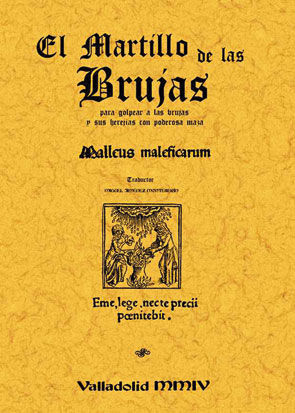
Spanish edition of the Malleus Maleficarum (1486)
by inquisitor
Heinrich Kramer.
Another point to note is that, before this period, witches were
still comprehended as beings that could use a technology to control
the powers of nature - shamanic; after this period, they were known
as beings that only channeled evil into the world because they were
under the control of the Evil One.
They were all purely Satan's puppets and
no good could ever come from them.
The Malleus Maleficarum
specifically mentions that,
"witchcraft is chiefly found in
women because they are more credulous and have poor memories",
and because "witchcraft comes from carnal lust, which is in
women insatiable".
(Sprenger and Kramer. Malleus
Maleficarum. 1968, pp. 41-48.)
The political uses of these ideas should
be obvious.
Sprenger and Kramer, et al., came along
and wrote books describing healthy, competent, intelligent women as
witches, and presto! Problem solved.
All the excess women (or anybody, for
that matter) can be gotten rid of; all the autonomous women with
property can be done away with and their property confiscated; and,
at the same time, the psychological control of men over women,
re-establishing the subservience of women to the Church, can be
accomplished in one fell swoop!
(One also has to consider the
destruction of many genetic lines of powerful women - shamanic lines
- in this process, which has been ongoing, so it seems.)
One of the most distressing results of this change in attitude
toward witches was the creation of witchcraft as a systematic
anti-religion in the minds of its persecutors; it became the
opposite of everything that Christianity - both Catholic and
Protestant - stood for. Witchcraft as an elaborated system of
religion was unknown before the fifteenth century. (This is why
modern-day reconstructions are not likely to be very accurate.)
This was a period in which a theory of
supernatural demons was invented and crystallized as an explanation
for the evils that fell upon mankind.
How else to explain the Black Death
which killed indiscriminately in spite of the prayers and
supplications of the priests of the Christian church, both
Catholic and Protestant?
It seems that the legends of gods fighting in the skies (the
break-up of a giant comet 13,000 years ago) were later corrupted
into certain Gnostic ideas such as the 'cosmic error'.
Certainly, at a certain level, there is
duality, otherwise nothing would exist, but this Gnostic take on
things went way too far with these ideas.
(See:
The Other God by Stoyanov for a
better understanding of Gnosticism, keeping in mind the work of
Victor Clube and Bill Napier.)
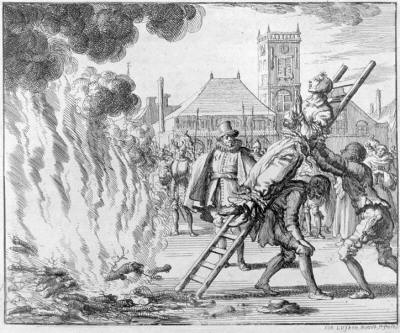
The 'witch myth' was created in the late 1400s in reaction to the
Black Death - cometary destruction on an almost unimaginable scale -
and this 'myth' consisted of a whole, coherent system of beliefs,
assumptions, rituals, and 'sacred texts' that had never existed
until this time and that were created by a couple of psychopathic
accusers!
The Dominicans developed and popularized
the conceptions of demonology and witchcraft as a negative image of
the so-called 'true faith', and the Protestants were just as busy!
What all this means is that being a 'Witch' in the time of the witch
persecutions must have meant something more akin to following a
dualist belief system similar to the Cathars, being an observer of
nature, astronomy, speaking truth to power, really, more like how
Burton Mack described the early Jesus People.
It probably also meant being able to
'see the unseen' in terms of cosmic, social and human energies, to
'walk between worlds' as the Paleolithic shamans did, and to use
these abilities on behalf of other people. Perhaps the image of the
witch flying on her broom across the face of the full moon was
actually a corrupted ancient symbol of a comet with a tail
personified as woman?
A comet came and nearly destroyed humanity at the end of October
13,000 years ago, and impacting debris from the same comet brought
Judaism, Christianity, Islam and, later, the imposition of
Christianity on the Western world. Later still, the same comet
stream brought the Black Death and the persecution of witches, both
male and female.
This scapegoating was utilized to get
rid of a lot of individuals who threatened the status quo - the
control over the masses - and that included a great many
strong, independent women.
And so, today, we associate witches with
Halloween, the end of October, and the anniversary of the
destruction of nearly all life on Earth.
It is just a variation on the 'Eve
ate the apple and brought about the fall in Eden' story, created
by psychopaths who hate women and all they stand for:
-
Creation
-
Nurturing
-
Service to Others
Indeed. The calamities of that time - of
any time - assault religious faith.
And anyone who talks about such
calamities in a reasonable and factual way as just what Nature does,
and who backs it up with scientific data, must be silenced because
they threaten the very foundation of Western Civilization:
Judeo-Christianity, and
Uniformitarianism, and Fascist control of humanity.
|






















